「非物質文化遺產項目」講座 Intangible Cultural Heritage Inventory Lectures
螳螂拳講座(黃毅英)
Six lectures on the Praying Mantis School of Chinese martial art (Ngai-Ying Wong)
1. 螳螂拳的起源與系統THE ORIGIN AND DEVELOPMENT OF THE PRAYING MANTIS SCHOOL
※ 緣起及目的 – 讓 先生之術德學髓公諸於世。「藏諸名山,傳之其人」,望後世有才德兼備者能於螳螂拳慕之、好之、樂之、習之、傳之。Intention – There is only one simple objective for delivering these lectures as well as setting up the website【https://www.hfwong-mantis.com】: “to keep an archive of Master Wong’s treasures and make them known to the public. As an ancient Chinese saying goes ‘preserve the treasures in the depth of mountains for the right person’. It is our sincere wish that there will be someone who truly admire and respect the teaching of the Praying Mantis School, put them into practice and pass them on to the next generation”.
※ 起源Origin【按1948年《螳螂拳術闡秘》. We follow what is laid down in Master Wong’s Revealing the secrets of the Praying Mantis School published in 1948】【see also https://www.hfwong-mantis.com/傳承-lineage/源流-origin/】
※ 十二字訣。Wang, the founder, summarised praying mantis’ combat skills into twelve essential points【https://www.hfwong-mantis.com/螳螂拳講座】
※ 猿步八法。He also incorporated 8 stances of the alps【《螳螂拳典》Treatise of the Praying Mantis School published in 2020.】
※ 十七家法。He further synthesised 17 other schools【https://www.hfwong-mantis.com/audio-video/螳螂拳要義/】
※ 源流Developing【https://www.hfwong-mantis.com/傳承-lineage/源流-origin/】
※ 南傳:羅光玉Master Lo was the one who brought Praying Mantis martial art out of Shandong and have it transmitted to Southern China【https://www.hfwong-mantis.com/傳承-lineage/羅師公-master-luo (this page contains brief English biography of Master Lo)】
1889:羅師公誕生Master Lo taken birth。
1907:羅師公隨范公習螳螂拳Studied Praying Mantis martial art under Master Fan。
1919:羅師公受聘於中央精武體育會為總教練Employed by Central (Shanghai) Chin Woo Athletic Association as Principal Coach。
1921:香港精武體育會成立Hong Kong Chin Woo established。
1929:弟子馬建超(成鑫)參加全國運動會第一屆國術比賽獲冠,弟子陳震儀上海市運動會獲冠Lo’s disciple Master Cheng-yin Ma won champion in the Chinese martial art competition in the first National Athletic Meet, his disciple Master Zhen-yi Chen won champion in the Shanghai Athletic Meet。
1932:羅師公到港精武任教,第一屆全港國術公開比賽團體操,羅師公領導精武會男子拳術(崩步拳)奪冠Lo began teaching at the Hong Kong Chin Woo Athletic Association. He led his disciples to attend the first Hong Kong Chinese martial art competition, which won champion with the performance of BengBu。
1934:黃宗師隨羅師公往粵參加第十三屆運動會奪錦而歸。Master Wong joined Master Lo’s team and won in the 13th Guangdong Athletic Meet.
1935:廣西全國運動會,派黃錦洪獲優勝,三戰三捷獲德鄰杯(李德鄰)Master Lo sent his disciple Master Kam-Hung Wong to participate the National Athletic Meet in Guangxi, who won the De Lin trophy。
1936:羅師公派黃宗師漢口精武分會教螳螂拳Master Lo sent Master Wong to Wuhan to teach at the Hankou Chin Woo Athletic Association。
1936:中央國術館南巡,羅師公參與接待並於太平戲院演三節棍。Master Lo took part in receiving the Central Chinese Martial Art Academy’s Hong Kong visit and performed the three-section rod.
1939:羅師公離開精武。辦民強體育會。Master Lo left Chin Woo and established the Man Keung Athletic Association.
1942:羅師公離港返滬。Master Lo left Hong Kong for Shanghai
1944:8/2(元月十五日)羅師公逝於上海Master Lo passed away in Shanghai on the 8th of February。
※ 精武Chinwoo【https://www.hfwong-mantis.com/香港精武三十年】
1909:陳公哲、農葝蓀、陳鐵生等於上海組織精武體操學校,請霍元甲出任總教習。Gung-jie Chen and his colleagues established the Chin Woo Gymnastic School in Shanghai, invited Master Yuan-Jia Huo to the post of Principal Coach。
3/1909:霍元甲來滬及與奧皮音等作擂台比武Master Huo fought in a martial contest。
9/1909:霍元甲逝世Master Ho passed away。
3/3/1910:精武體育會開學Inauguration of the Chin Woo Athletic Association。
1911:首屆運動會First athletic meet。
1917:女子部成立Woman’s section established。
7/7/1918:漢口分會成立Hankou Association established。
1920:五特使(陳公哲、羅嘯璈、陳士超、葉書田、黎惠生)先後到訪了越南、新加坡、馬來西亞、印尼等地Five ambassadors visited Vietnam, Singapore, Malaysia and Indonesia。
1921:香港會成立Hong Kong Association established。
※ 宗師Master Wong【details can be found in https://www.hfwong-mantis.com/傳承-lineage/宗師-master-wong】。
※ 三派Though we have three sets (seven stars, plum and plain), they belong to a single Praying Mantis school. Mr Wong objects segregation【https://www.hfwong-mantis.com/三派同源】。
2. 螳螂拳的學習進程The course of acquiring techniques in the Praying Mantis School
※ 網站介紹Introducing the web site【https://www.hfwong-mantis.com】。
※ 騎馬式及登山式作開端,之後學習基本套路,再進為領拳。 【https://www.hfwong-mantis.com/螳螂拳講座】、對打、兵器練習、兵器對打等,乃至搏擊Learning starts with knowing the stances (horse riding and mountain climber), then routine sets, paired sets, sets with opponents, weapons, weapons with opponents, combat skills。
※ 功力拳:精武十套基本拳【「精武基本十套」:功力拳、大戰拳、節拳、接潭腿、套拳對打、八卦刀、群羊棍、五虎槍、單刀對槍】Some of the ten Chin Woo basic sets are selected to teach。
※ 入法出法Building a path from ‘entering the way’ to ‘transcending the way’。
※ 套路之次序:功力拳、崩步、十八叟、躲剛、插捶、白猿出洞、白猿偷桃、大架式、小架式、大番車、小番車、一路摘要、四路摘要(即梅花落)、五路摘要(即梅花拳)、六路摘要(即梅花手);五郎棍、八卦刀、領崩步;彈腿十四路;二路摘要、三路摘要、黑虎出洞、黑虎交叉、螳螂出洞、螳螂偷桃、螳螂捕蟬、四路奔打、飛雁掌、落鷹掌、柔靈、連環錦套、攔截、左右連環扣、連拳、醉羅漢、醉打蔣門神、醉劉唐、醉螳螂、八肘Learning different sets step by step。
※ 教學手法:如果一時未能領會,先教手法、再教步法。十四路、十八叟、黑虎交叉左右對稱。左右反轉來打【《螳螂拳術隨筆續集》「如何可使左右平均」】。Modes of instruction. Breaking down into smaller tasks for those who could not catch immediately. Reversing left and right 。
※ 忌貪多,領悟不同套路的剛柔緩速【https://www.hfwong-mantis.com/audio-video/螳螂拳要義/】Avoid learning in a haste, should contemplate on the feature of each set。
※ 每套拳之長短(多少式)、緩急、剛柔、側重點(如側重捶法、掌法、番車手、跌撲,轉身、腿法)均有所不同。故不應忌貪多亦不嫌多,每套細味之。Contemplate on its length, slow vs swift, hard vs soft and emphasis。
※ 套路之名稱(如躲剛、大架式、番車、柔靈、飛雁掌),宗師序文、引言。Understand more from the name of the set and preface/introduction of Master Wong’s various books。
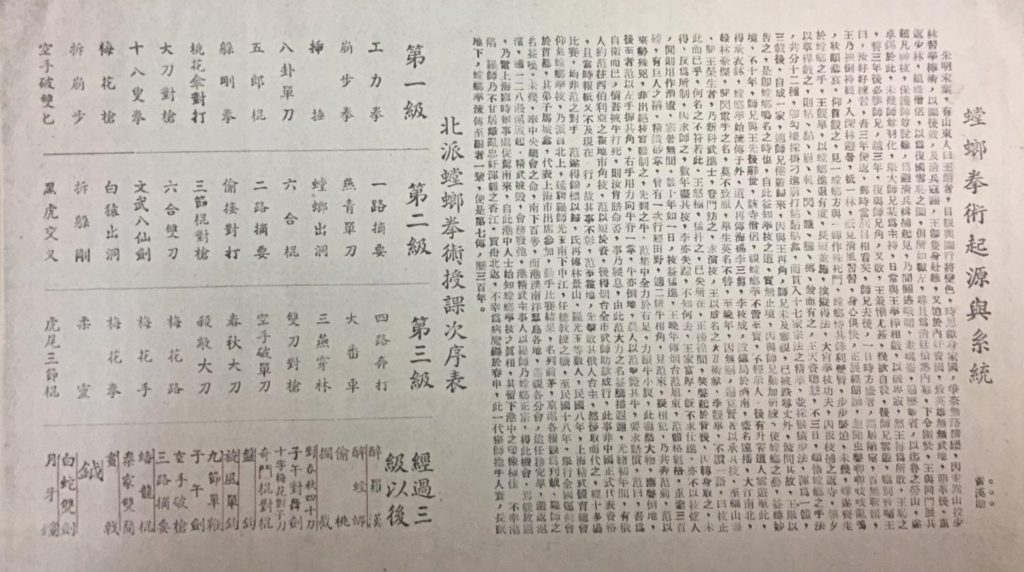
3. 宗師開班實況及兵器簡介How Master Wong’s classes were conducted
※ 單雙日(7~9)、特別班(2~4, 10~12)、搏擊班、羅漢功班、傷科班、拳師班Odd day (Monday, Wednesday, Friday evenings)/Even day (Tuesday, Thursday, Saturday evenings) classes, Special class (Saturday afternoons and Sunday mornings), combat class, Lohan Gung class, bone setting class, tutor preparation class。
※ 熱身:踢毽、沙包、壓腿Warm up: shuttlecock, sandbag, leg press。
※ 雨天、中秋、過年、生日、關帝誕Rainy days, mid-autumn festivals, Chinese new year, Master Wong’s birthday, graduation ceremony on Guan Di’s celebration day。
※ 個別教授、操拳Individualised instruction。
※ 何以螳螂拳有那麽多的套路?Why there are so many sets in the Praying Mantis School? 《連環錦套》引言:「有人指出每套拳之間是許多重式,是多餘者,其一年級與二年級所讀之書內文又何嘗不是許多重字與重文?習拳初期務必多認識招式、變化、順逆、左右、前後俱有不同之組成,同時更可刺激練習情緒,使習者時常有新的變換、新的認識,又何嘗不可以增益於學者?」Master Wong explains: Though the vocabularies in Grade 1 and Grade 2 Readings duplicate, they are not repetitive. Practitioners should realise the different combination and variations of these poses。
※ 散手訓練:桃花傘、偷接、外裡粘手、外裡掛手、黑虎偷心、磨盤三手、番車轆轆捶、燕青對子(即拍按)Besides different routine sets, there are paired combat skill training sets。
※ 兵器簡介Introduction to various weapons【refer to《螳螂拳典》Treatise of the Praying Mantis School published in 2020】。
※ 拳師資格、素養、手册、訓練Master Wong’s guideline on becoming a master。
補充:踢毽練習
褚(褚民誼)曾一度出任中央精武總會會長之職,至其對體育之建樹,則有踢毽子、太極球等。踢毽子運動,或有人視之為兒童遊戲之事,但若能身體力行去鍛練,則知其對運動之功能矣。嘗見褚氏於全國運動會中,以此作演出。褚為大胖子,但為其踢毽子時,則前後抽打,左右挑交,踢出許多花式,使觀之者有如遊龍之矯捷,毫無大胖子之呆鈍態。余亦嘗集同學數人作此運動(足網毽),僅十數分鐘,便即渾身發汗,對運動之目的即可於短短時間內獲得矣。當日褚氏提倡此項運動時,頗有人笑其不長進,但褚氏則解釋曰:「運動不論古今中外,但求符合運動原理,便是成功之境域。國人不自量力,妄自提倡舶來運動,試思吾國人之經濟能力,能否挪出金錢去建築運動場?能否如外國勞工制度之有八小時運動與娛樂之規定?在環境之需要下,是以吾乃提倡民間之古老運動。」
《武林知聞錄》
4. 各手法漫談Standards of various postures
※ 掌法、捶法、指法、爪法、肘法、手法、步法、腿法、手腳練習法、兵刄談palm, fist, finger, craw, elbow, arm, stances, legs, arm & leg exercises and weapon【《螳螂拳典》Treatise of the Praying Mantis School、https://www.hfwong-mantis.com/螳螂拳講座】。
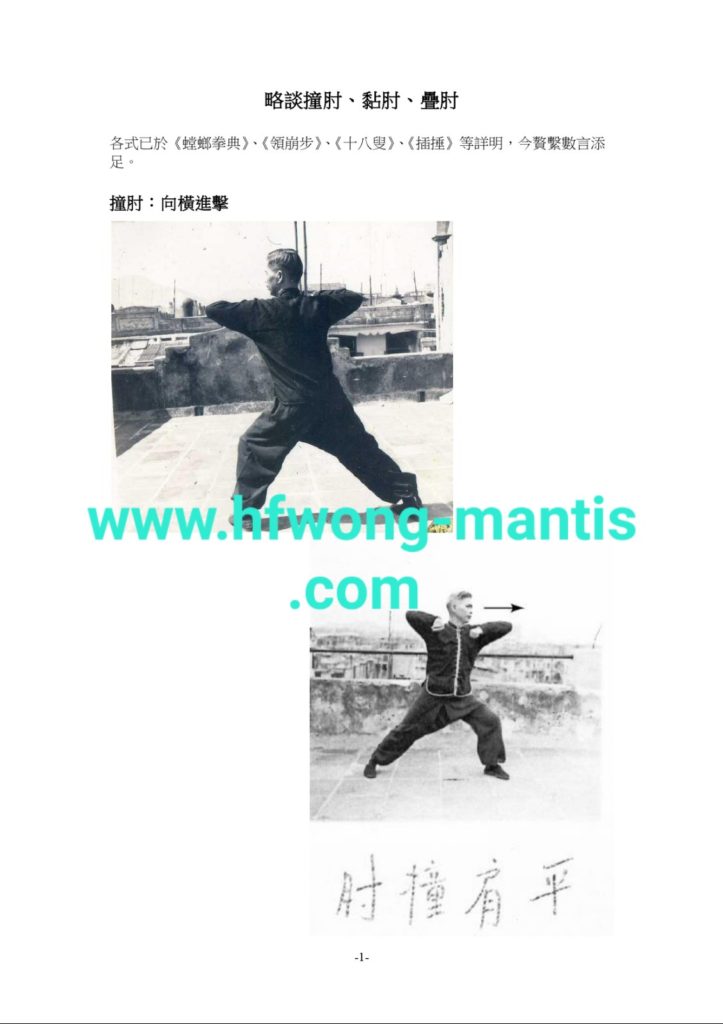
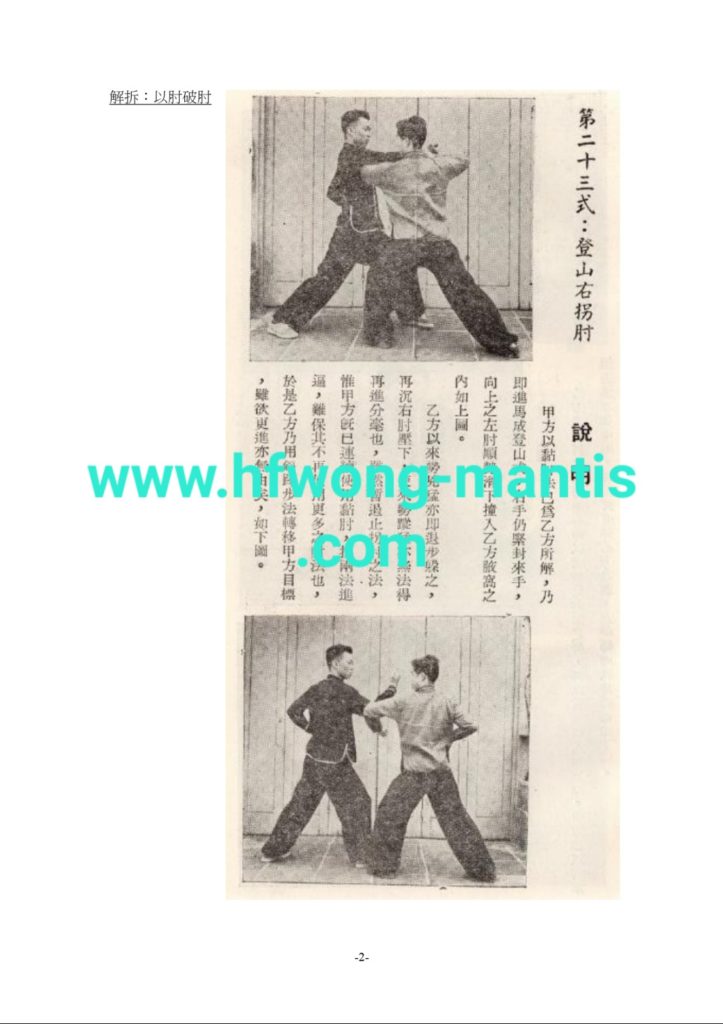
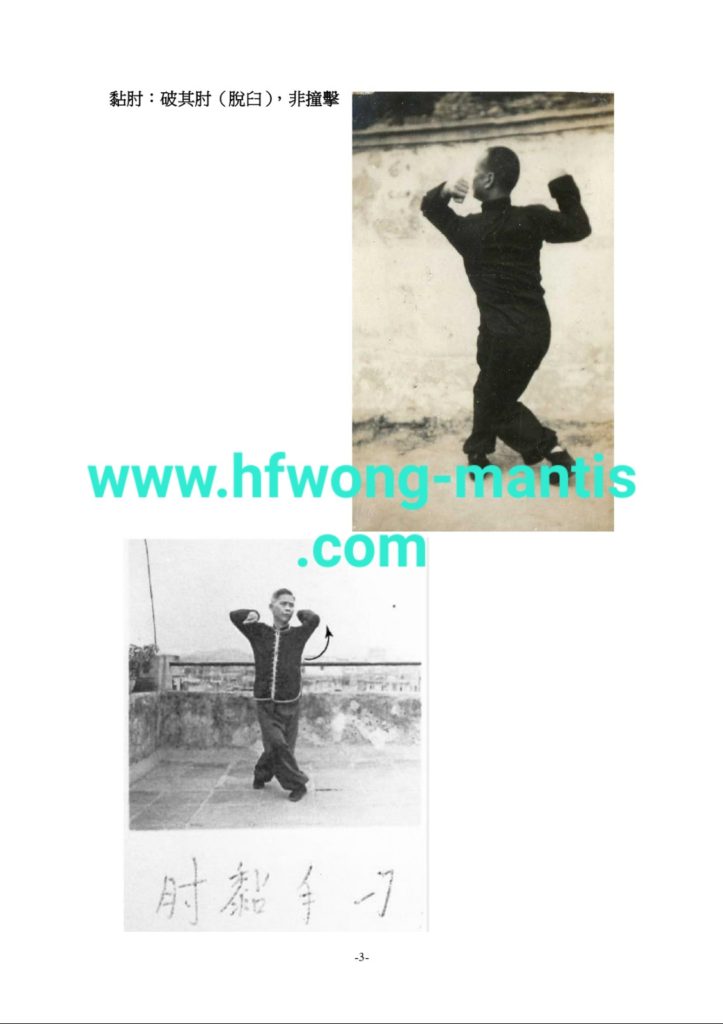
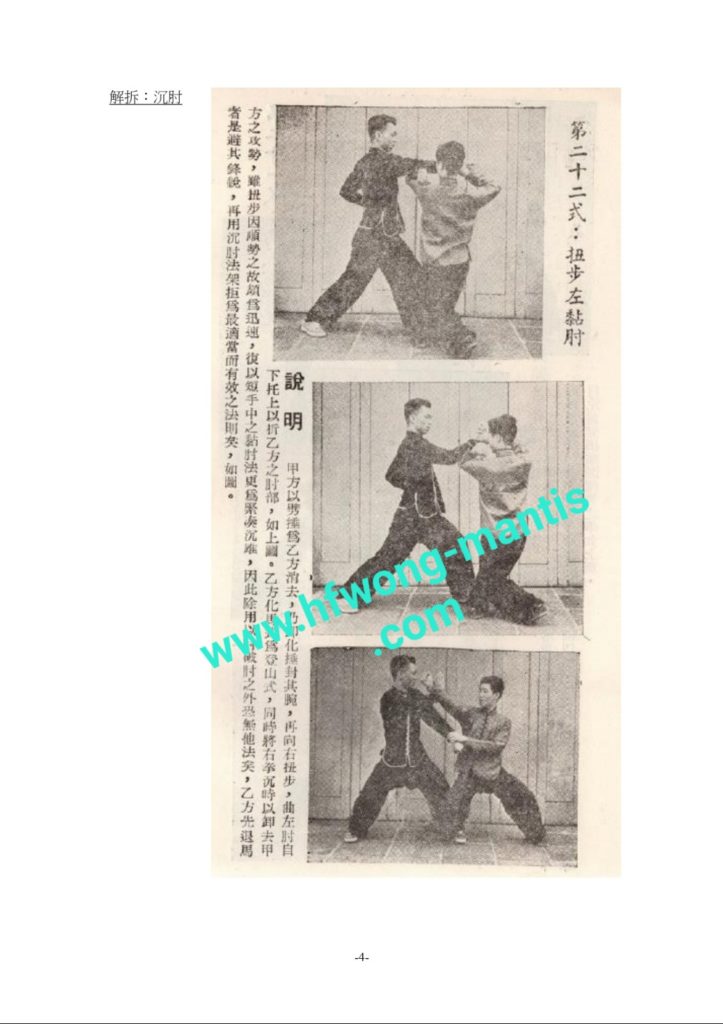
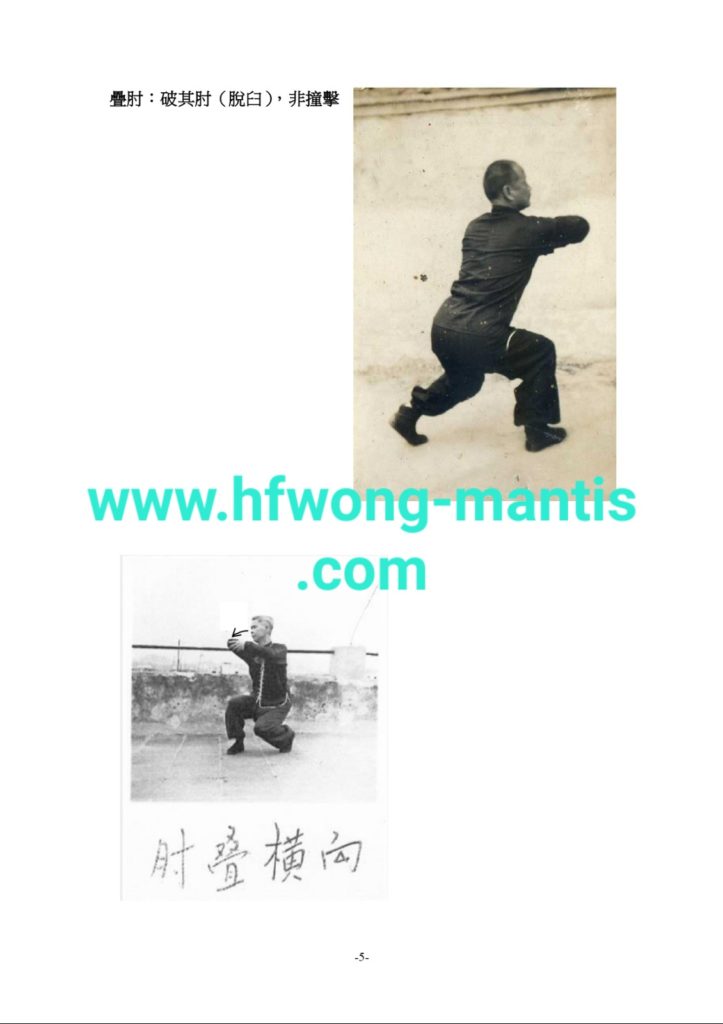
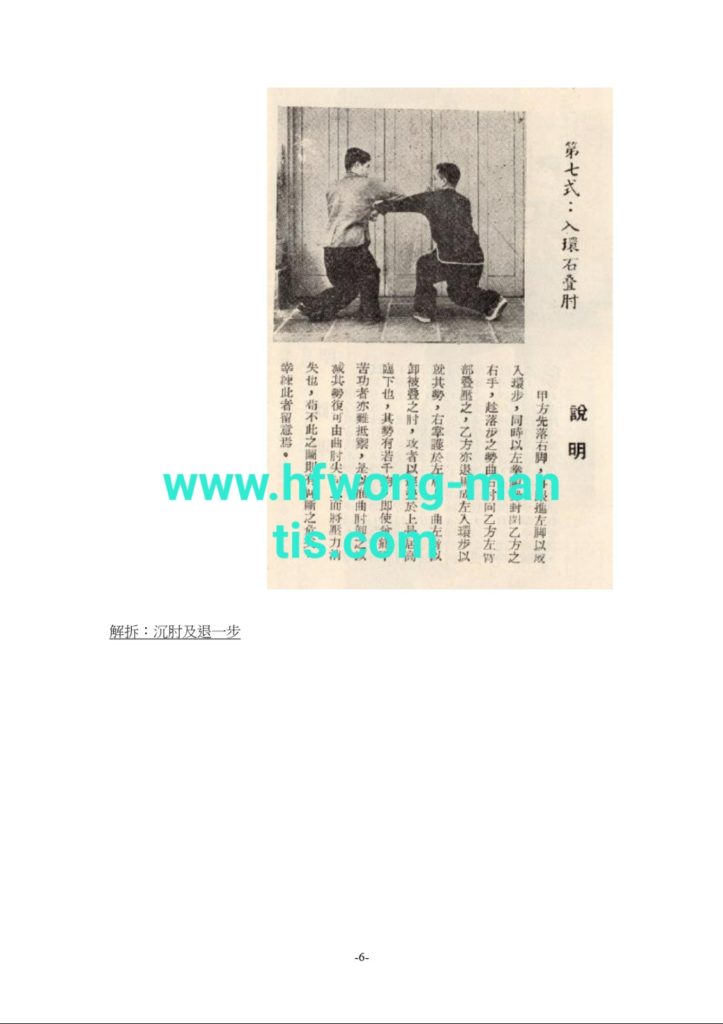
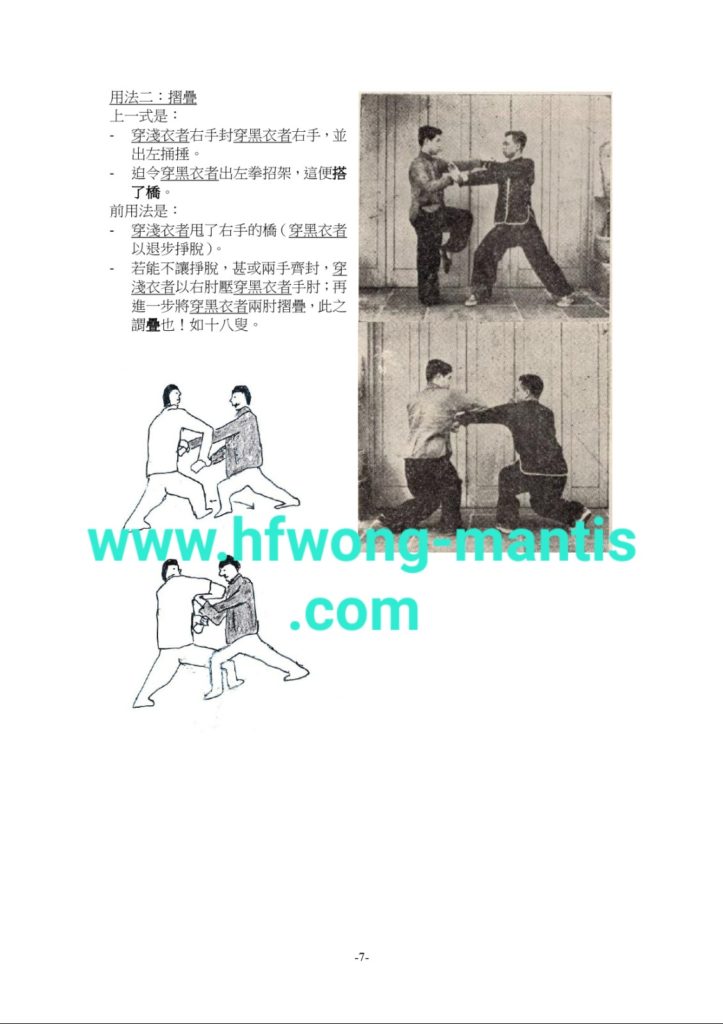
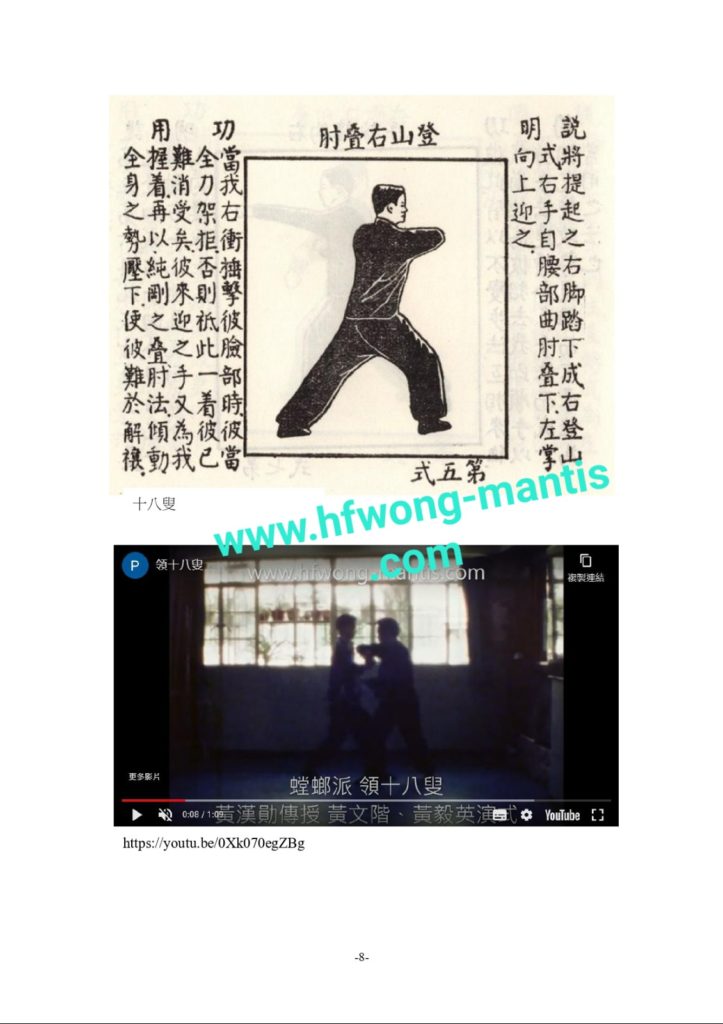
5. 螳螂拳之特色Features of the Praying Mantis
School
※ 內家拳、外家拳?There has been discussion whether
the Praying Mantis School belongs to the inner or outer school? – 黃梨洲《王征南墓志銘》:「少林以拳勇名天下。然主於搏人。人亦得以乘之。有所謂內家者。以靜制動。犯者應手即仆。故別少林為外家。」一般泛泛而言為內家不只有「外力」,亦能使出「內勁」,而螳螂拳亦有之。螳螂拳除了吸收螳螂搏鬥之形神,亦吸收了十七家法These
discussions mainly base on the epitaph written by the great Chinese scholar Lizhou
Huang (1610-1695) in the late Ming dynasty on his friend Zhengnan Wang, who
belonged to the Wudang school. But such a distinction is rather vague. The Praying
Mantis school also applies “inner strength” and it already synthesized the bests
of 17 other schools。
※ 宗師曰:螳螂是介於剛柔之間,長短互用,快慢相輔者並詳述其訣曰:螳螂有八剛,十二柔之法,豈非介於剛柔耶。更有七長八短之法,斯為長短之證乎,拳經又云,出手快,盤架慢,此非快慢相輔而何Master Wong said in a TV interview that “The Praying Mantis school strikes a balance between the forceful and gentle, applies both long and short, with swift and slow complementing each other。
※ 剛柔Forceful vs gentle –
※ 八剛十二柔The 8 forceful strikes and the 12 gentle moves【https://www.hfwong-mantis.com/螳螂拳講座】。
※「彼若以剛攻,我以柔對;若以柔攻,則以剛對。」 “If someone attacks you forcefully, you react gently; and if someone attacks you gently, you react forcefully.”
※《少林真傳》卷四云:「吾剛也彼亦剛,吾剛無所用乎?曰:患吾之剛,非真剛耳!When the forceful faces the forceful, what worries us is that ours is not truly forceful.
※ 柔能尅剛The gentle can counteract the forceful。
※ 柔亦未嘗無剛,只善用其剛耳Gentle does not mean having no
force, but applies the force tactfully。
※ 七長八短7 longs and 8 shorts。
※ 長拳短打long and short strikes complementing each other。
※ 出手快、盤架慢swift strikes but slow standstills【please refer to https://www.hfwong-mantis.com/audio-video/螳螂拳要義/】。
※ 虛實Fluid and solid。
※ 勢Xi (potential) 。
※《易經》:得時、得中、得位Grasp the right time, the right ‘middle’ and the right position (The Book of Changes)。
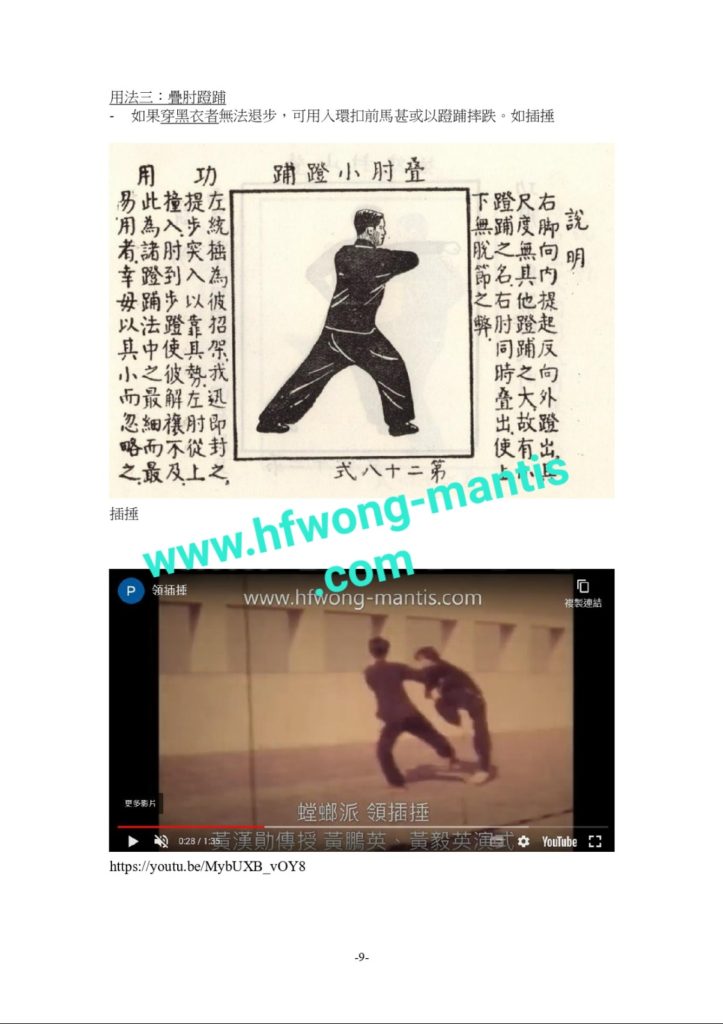
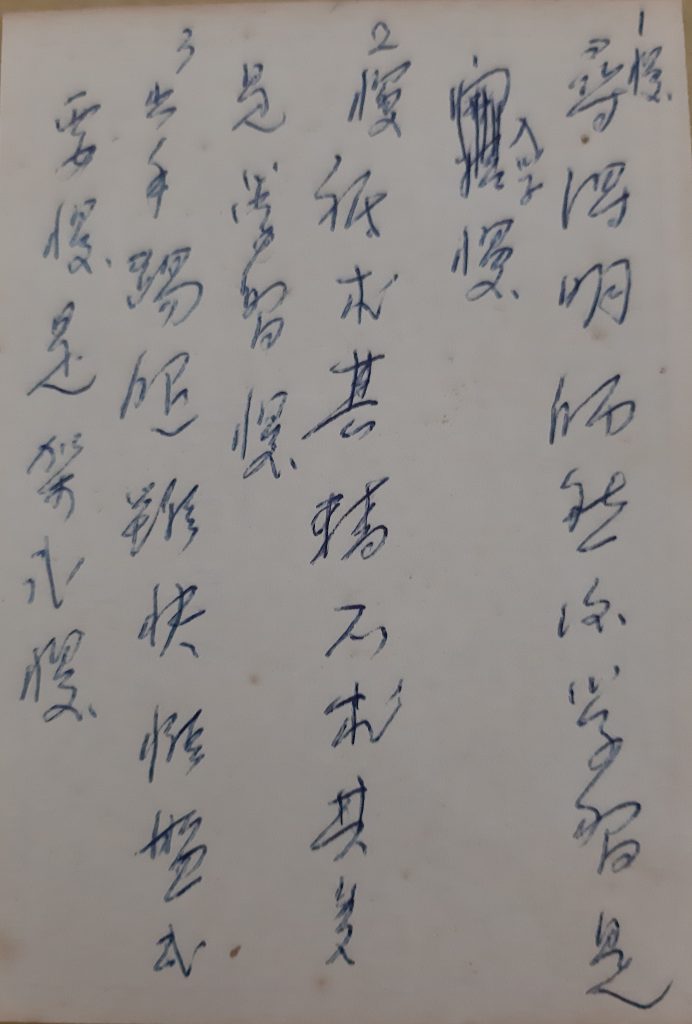
6. 《少林真傳》探玄Unfolding the secrets in Authentic Teaching from Shaolin
※《黃漢勛先生服務國術界四十年榮休紀念特刊》〈國術興替史〉:「本門祖師范旭東氏承歷代祖師口授訣要而著有少林真傳五卷,恩師羅氏蒙范公盡賜之,漢勛亦蒙恩師賜予抄全。至香江淪陷,恩師北返,臨行謂漢曰:『離亂艱危之際,余此番北歸未知相會何時?身邊又缺可贈作紀念之物;汝待余不錯,任教又已多時,成績不惡,今後光大本門之責,汝祈努力為之。』言已在行囊中檢出范公親手書寫之一卷授漢,當漢正欲伸手接受時,恩師再鄭重言曰:『此卷書萬勿遺失,更宜再四體味其中深意,毋負余叮嚀致囑之語。』」The Teaching was compiled by Xing Shao Dou Ren and pass on from generation to generation. Master Lo let Master Wong copied all five volumes before Master Wong headed to WuHan. Before Master Lo left Hong Kong to returned to Shanghai, he gave Master Wong Volume 4 which Master Fan with Chinese brush.
※《少林真傳》各卷之內容【please refer to《螳螂拳術真傳》】Content of the Teaching: Master Wong published most of them in various books like Revealing the secrets of the Praying Mantis School, Scores of Sets in the Praying Mantis School and Treatise of the Praying Mantis School
※ 丹道、内觀圖相Others include various Daoist techniques。
※ 要害、八打八不打vital points, 8 to-strike-points and 8 not-to-strike-points【螳螂拳講座】【https://www.hfwong-mantis.com/螳螂拳講座】。
※ 點穴striking the acupoints。
※ 鐵砂掌iron sand palm。
※ 不同時辰行不同穴位Flowing through different points according to time。
※ 經與穴之間的關係The relationship between acupoints and channels。
※ 藏象學說The five elements and their relationships with organs, season, etc.。
※ 羅漢功The Lohan Gung。
※ 針灸之子午流注及靈龜八法Theories in acupuncture that relate to the clock。
※ 截脈Stopping the channel flow。
※ 人神deities in the human body。
※ 甲子配二十八宿及廿四節氣,天根月窟、春夏秋冬圖The 24 seasons and related theories。
※ 定甲子:冬至,日月合璧、五星珠連determining the starting point in the Chinese calendar。
※ 解穴:藥方與反針unlocking acupoint strikes。
※ 結語:健身?技擊? – 一門學問,蘊含藝、術、道Conclusion: martial art as a discipline: art, techniques and Dao。
口誤
※ 閃,賺,騰,挪。「賺」有兩個可能的解釋。一是指拳術中「哄騙」的戰術,即虛虛實實之法。粵音「綻」(zaan6);另一是「趲」(粵音「盞」zaan2)字之轉,快走、挫身竄走之意【第一講】。
※ 「騎馬、登山、跨步、入環、七星、撲腿、中式、吞塌 」 應為「騎馬、登山、跨虎、入環、七星、撲腿、中式、吞塌 」【第一講】。
※ 「膻中」:有多個讀音。如「箋」(釋義:像羊肉的氣味)、或「但」(釋義:1. 袒露。2. 胸中)。網上云:「查閱《康熙字典》,『膻』有『壇』(tan)的讀音,且它是『膻』的主導發音——『膻』。…因此,『膻中穴』的『膻』正確讀音應該為『tan』——傳統中醫讀『膻』為『tan』,並不是錯讀白字,而是代代相傳的正確讀音!」云云【第四、六講】。
※ 昆吾良刀【第五講】。
※ 八短:頭、臀、膊、胸、膝、肘、爪、錘。「臀」粵音「團」【第五講】。
※《七星螳螂拳要論》1933年抄自羅公光玉老師來自廣州郭子碩老師【第六講】。
※ 任脈和妊娠有關【第六講】。
父親錄音用「占」音;
父親《武林知聞錄》第二集用「黃𫀅」(頁20);
漢超師兄《中國近百年螳螂拳術史述論稿》用「黃祜」(頁2),增訂版刻意更正為「黃佑」。此外於註4(頁11至14)論及。
漢超師兄《戚繼光拳經螳螂拳證義》用「黃佑」(頁71)。
漢超師兄雖云「以便考古者之探討」(《中國近百年螳螂拳術史述論稿》頁14),意即客套而不作定見,然師兄乃宋史專家,其採用「佑」自有其道理。惜哲人已逝,無法就教。不過當中涉及一人之名字,也許無關拳理宏旨歟?








「非物質文化遺產項目」演式 Intangible Cultural Heritage Inventory performances
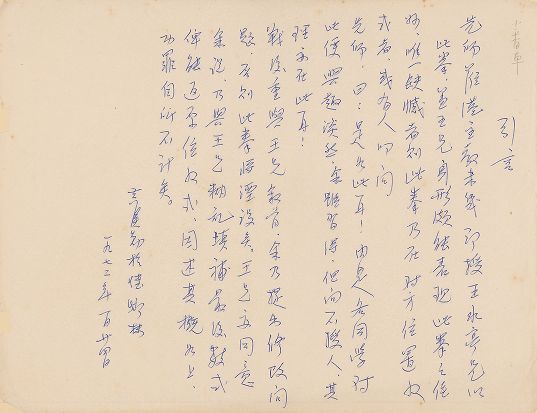
背轉雙覆掌 倒轉左捕蟬 入環單臂爪 雙封手軋腳 登山左叠肘 登山左崩捶 雙封手軋腳 雙封手扑腿 右前掃堂腿 七星雙刁手 入環雙屯掌 跨虎右挑掌 跨步左切掌 跨步右切掌 雙封手軋腳 雙封手扑腿 左後掃堂腿 七星雙刁手 入環雙屯掌 双刁手揪腿 穿掌右蹬𨁏 登山左圈捶 跨虎右截捶 踢腳右滾膀 引針右腰斬 刁手右圈腳 跨虎右挑掌 入環右滾手 進式右漏手 七星左撑掌 七星右撑掌 雙封手軋腿 掛統躲腿式 七星右劈軋 轉身雙捆腿 登山左掛統 雙封手軋腳 雙封手扑腿 左後掃堂腿 右前掃堂腿 登山右圈捶 跨虎左截捶 入環左滾膀 倒勢右捕蟬 入環單臂爪 雙封手軋腳 登山右叠肘 登山右崩捶 雙封手軋腳 雙封手扑腿 左後掃堂腿 七星雙刁手 入環双屯掌 跨虎左挑掌 跨步右切掌 跨步左切掌 雙封手軋腳 雙封手扑腿 右前掃堂腿 七星雙刁手 入環雙屯掌 雙刁手揪腿 穿掌左蹬𨁏 登山右圈捶 跨虎左截捶 踢腳左滾膀 引針左腰斬 刁手左圈腳 跨虎左挑掌 入環左滾手 進式左漏手 七星右撑掌 七星左撑掌 雙封手軋腳 掛統躲腿式 七星右劈軋 轉身雙捆腿 登山右掛統 雙封手軋腿 雙封手扑腿 右前掃堂腿 右後掃堂腿 登山左圈捶 跨虎右截捶 入環右滾膀 倒勢捕蟬式
「非物質文化遺產項目」口述歷史訪問 Intangible Cultural Heritage Inventory Oral History interviews